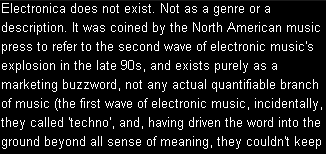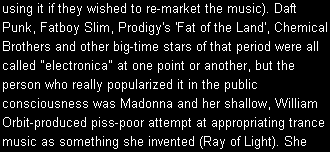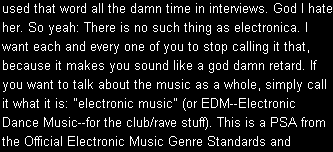View current page
...more recent posts
Our tax dollars at work: in case you didn't hear, Ahmad Chalabi has been named oil minister in Iraq's shaky, US-propped-up government. They say it's "interim"--yeah, right. This sleazy con man, the Administration's pet Iraqi exile during the Saddam years, provided much of the fake weapons of mass destruction "intel" that dragged us into war in his country. He is a fugitive from justice in Jordan after embezzling millions from a bank there, and has been accused of passing classified information to the Iranians. Iraqi ministers get to hand out patronage positions, so he'll soon be surrounding himself with cronies and hobknobbing with US oil companies, as he prepares to rob his countrymen blind of their biggest material asset. It's sickening the US has aided this creature in his climb to power, with tax money and the lives of so many soldiers.
Jack Masters responds on his blog to the following mildly sniping paragraph posted here a few days ago:
The castlezzt.net guy has a blog now. He's posting under the name "Jack Masters." Interesting pictures, funny/surreal descriptions of dreams, wry philosophical musings, including thoughts on Excel charts that make me suspect a connection to the IT industry (who else would care about Excel?). He's been updating castlezzt, too, and I guess it was inevitable given the cost of bandwidth that "the mile long web page" has been broken into multiple pages.Masters' reply, accompanied by this great Pokey the Penguin drawing (thanks, anonymous):
Sorry, man. I was doing some heavy interpolating (and projecting).
My bandwidth is fine, it's just that it was getting to be quite an ordeal to load the page.
Actually I have no connection to the IT industry at all, I just use excel to record ideas. It has certain advantages over a simple text file, because you can easily rearrange things, or even have the computer alphabetize or randomize them. My notes tend to take the form of lists anyway.
In the screenshot that accompanied the excel post, I was using it to map out the edge permutations of a blank jigsaw puzzle I was working on. I've also used it as a poor man's cellular automata, and various other things.

Top: Lucas Samaras. A couple dozen brand spankin' new Apple flat screen monitors are arrayed on tables inside PaceWildenstein, as in a classroom or library. From a central server one can call up hundreds of photo stills or Quicktime videos by the artist, documenting his strange solitary existence inside a luxury high rise garret in Manhattan. A handful of elementary Photoshop filters are employed to psychedelify mundane actions such as blowdrying his hair and beard, watching TV by himself on New Year's Eve, recording sunsets and Macy's Thanksgiving floats. Kind of poignant, all this, and occasionally stunning despite the familiarity of the effects. Below: Walter Redinger of London, Ontario, who shares Mitchell Algus' gallery with Banks Violette this month. The sculptures below are the artist's trademark fiberglas resin, suggesting Yves Tanguy by way of the Star Trek props department, or Max Ernst with a plague of boils--and I mean all that in a good way. Very strange, excellent sculptures. A bit more on Redinger here.
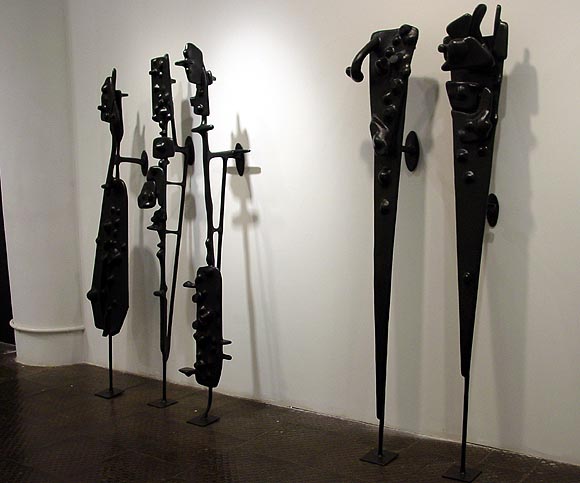
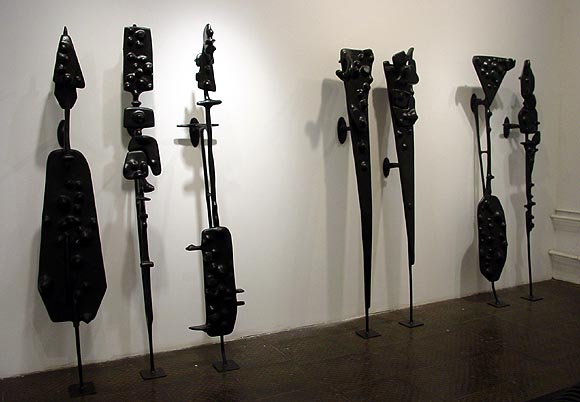
Eyebeam has organized a contest on the theme of contagious media, the idea being to come up with a meme (project, hoax, web page, joke) that gets you the most hits within a certain period of time. This occupies an awkward zone between social sculpture (art), public relations (not art), new media art, and web-development-as-usual. Participants in the workshops include Nick Denton of Gawker media, who didn't wait to see how the unruly and amorphous new form of expression called "blogging" would evolve but rather led the charge in turning it into something streamlined and branded a la the late 90s dot com model. Blogs under the Gawker umbrella are much like the one you're reading except they have nicer logos and blinking ads interspersed with the copy. They do get hits though. This page has had a couple of mentions on a site called Screenhead (thanks, mon) and both times stats spiked big time.
Speaking of stats, mine are great, thanks. Numbers aren't crowed about here like they frequently are at Josh Marshall's blog but let's just say they're very encouraging and I appreciate everyone who reads. One of the discussions I had early on with fellow bloggers at Digital Media Tree (a collective that is the brainchild of tech whiz Jim Bassett) is that blogging isn't like dot coms because it isn't about number of eyeballs but quality of eyeballs. "Paradigms (memes, whatever) grow around communities of strong interest" is another way of saying it. Well, maybe they do, maybe they don't--you never know what's going to be important in the long or short run. But a perverse thing about the Internet is too much success can destroy the effort before it begins: bandwidth costs money, and more traffic makes blogging more expensive. To accommodate the traffic you have to upgrade and put up ads or a tip jar to keep going.
It can be exhilirating to have a contagious project take off, but recent history teaches us the party's quickly over and you're left picking up your guests' cigarette butts. The only solutions to the problem of the hit meme are to embrace capitalism, quit while you're ahead, or be like the characters in Kurt Vonnegut's short story "Harrison Bergeron," who wear prosthetic devices that blunt their natural talents (thick eyeglasses for painters, heavy ankle weights for ballerinas) so they're perpetually good but not too good.
And when it's all said, what did "Turkish Man Kiss You" and "America We Stand As One" really contribute to the discourse? Is their "success" as ironic artifacts something that could, or should, be deliberately contrived?
Updated slightly to accommodate a good point from someone who seemed mildy surprised that these things get updated/rewritten after they're posted (let me know if you want credit for the thought in the last sentence). The rule of thumb is if the post changes substantively I do an "update," otherwise it's just sub-Orwellian tweaks.
Music Diary (some blabbery first-person musings previously posted were boiled down to the following):
The advantages of software synthesizers are being able to jettison gear and "stuff," use the biggest possible graphic interface to design music more visually, and access new sound making tools as they are developed via the Net, as opposed to just downloading samples. The key to using so-called native instruments is to have your eyes open about their agendas and limitations and if the music is going to sound "off the shelf," try to put brackets around it so people know what you're doing, even if they don't know what you're doing. As a result of being more softsynthian, won't the music produced around here sound increasingly like those bits of tuneful ambient e________a played between stories on NPR (assuming they still do that--it's been a while)? Yes, probably, but I'm at peace with that, I think.
By the way, the titular bleat in the "drum and bass" track "Little Shrieker" was a field recording of a woodchuck, distorted, slowed down, and played backward in Kontakt. I'm proud of that good bad noise, whatever anyone else thinks of it.
New York Times columnist Maureen Dowd is frequently annoying when she does her too-clever pairings of the foibles of world figures ("Saddam was found hiding in a hole; Bush has one in his head..." WHATEVER). She's better when she just does straight criticism of an Administration that is demonstrably screwed up beyond all recognition. Like today:
Even if his suave statesmanship were not so perfectly suited to high-level diplomacy, [John] Bolton should still get the [UN] job. A ruthless ogre who tried to fire intelligence analysts who disagreed with his attempts to stretch the truth on foreign weapons programs deserves to be rewarded as other Bush officials have been.Our fellow Americans, who so trustingly voted this Administration back in six months ago, are wising up, it seems. According to a recent Gallup poll, 50% of us now admit Bush actively lied about Iraq WMD. Whether we give a crap is another issue, but that's an encouraging statistic. Obviously the number would be much higher if Wolf Blitzer, et al, hadn't also lied. They knew all that WMD talk was a crock--any smart person did--but they just wanted to see things blow up good on their teevee programs.
After all, he was in sync with the approach of Condi Rice, Paul Wolfowitz, Stephen Hadley and Bob Joseph - who were all up for big jobs after they torqued up intelligence to fit the White House's theological beliefs.
Condi breezed into the secretary of state job, even after she helped Dick Cheney gin up the Iraq war, ignoring reports debunking the notion of Iraqi nuclear tubes, and even after she told Congress she'd shrugged at the Aug. 6, 2001, presidential daily brief headlined "Bin Laden Determined to Attack Inside the United States."
Mr. Wolfowitz was eager to sell the war, ignoring predictions of insurgency and possible civil war. So he and Donald Rumsfeld left our troops so stretched and vulnerable that they were reduced to using cardboard cutouts to stand sentry, and to jury-rigging Humvees that had not been properly armored, resulting in many lost limbs and lives.
So Mr. Wolfowitz now has the prestigious job of World Bank president.
George Tenet presided over the two biggest intelligence failures in modern history. He slam-dunked a Medal of Freedom out of them.
Jerry Saltz has a piece on artnet about the Artforum online diary. I looked at that journal, mostly chronicling who went to what opening after-party, a couple of times, got a creeped-out feeling and didn't go back. I understand the art world is suffering the influx of "Bush millionaires" who are chasing increasingly younger artists, but I'm removed from that process, in the sense that I'm not really a working critic these days who has to follow the nuances professionally, the way Saltz does. I'm confident the whole schmear will implode soon enough. I can relate to Saltz's story about giving a crit to the kid who'd just been picked up by a gallery, though, mainly as a viewer: I can tick off many reasons why I don't think, say, Julie Mehretu's work is "there" yet* but she's already been canonized by the gallery process--to the extent of having million-dollar lawsuits over the value of her art! This is real tulip mania stuff and I just can't get too concerned about it.
Jesse mentioned the Saltz article in connection with my rant about the "slow dimension" and the art world's stubborn refusal to get the internet. An alternative model for art production and critique will likely continue to grow in cyberspace while the art world bogs down in stuff that doesn't matter. The problem with the AF diary is it doesn't address ideas--it uses a kind of fake blog format to chronicle the personalities and flow of money, which is mildly interesting, but sort of a waste of a good medium. It's going to take a generation dying off before real substantive change occurs in the way art is made and consumed.
*Pointlessly busy, doesn't know what to leave out yet, murky content (is it really ethnic/political or is that all in the press release?), derivative of Matthew Ritchie, etc. etc...

The castlezzt.net guy has a blog now. He's posting under the name "Jack Masters." Interesting pictures, funny/surreal descriptions of dreams, wry philosophical musings, including thoughts on Excel charts that make me suspect a connection to the IT industry (who else would care about Excel?). He's been updating castlezzt, too, and I guess it was inevitable given the cost of bandwidth that "the mile long web page" has been broken into multiple pages.
Update: Jim says the computer monitor arch appeared on Gizmodo and has been making the rounds. They didn't credit it either. The image below is also good, no idea where he (Masters) got it:

AMC (The American Movie Classics channel on cable) ran an ad for a documentary they produced about the post-release editing of Hollywood content to remove "offensive" language and scenes. Didn't see the documentary, so I don't know whether the culprits were local TV stations, fundamentalist Christian-owned tech businesses or some combination. Either way, the outrage from people in the interview clips they showed led me to believe AMC thinks the practice is bad. Well, this is a howler coming from that channel, which up until 2001 or so showed movies intact, but now edits them for language and Orson knows what else.
A couple of examples of AMC's own practices:
Trivial (but still egregious): In David E. Kelley's weird horror comedy Lake Placid, about a 30-foot crocodile living in a Maine lake (an obvious homage to the young John Sayles), Betty White plays a crazy woman who has been feeding her cows to the croc for five years, treating it as a combination pet and pagan God to be appeased. The sublime Brendan Gleeson as a local cop confronts her at one point and the erstwhile Golden Girl ripostes, "If I had a dick this is where I'd tell you to suck it." OK, it's not all that funny but it's really not funny when "dick" becomes "____" and you still see her mouth moving.
Ahistorical and evil: One of the revelations of the Watergate years was that Nixon had a guy on his reelection campaign payroll named Donald Segretti, whose specialty was "ratfucking"--little dirty tricks like distributing flyers for opposing campaign events that never happen, releasing smears and rumors about the other guy etc. Part of America's fall from innocence in the '70s was learning that people at the very top thought and talked that way. Karl Rove, Bush's so-called brain, got his start in that campaign, so knowing about the practice and how sleazy these people are is still completely relevant. Anyway, to wrap this up, when AMC ran All the President's Men this bit of actual history was airbrushed to "rat____ing."
The "happy little E-tune" posted previously ([mp3 removed]--eventually it'll get a real title) is reinterpreted here on the SidStation synth: mp3 removed]. Also working on an extended remix of the Sid version, with drums, etc.
This version has more of that "videogame sound" because the Sid is built around the old Commodore SID chip. The machine isn't truly polyphonic: it has 3 oscillators and a kind of step designer feature called "wave table synthesis" that can be used to write multi-voice songs, but I haven't burrowed into that yet. One person who has is Jotsif, who posted some fine tunes on this Elektron Instruments forum thread.
If you don't use wave tables, in order to play several melodic parts simultaneously you have to "overdub" them, in a sequencer, as separate digital audio tracks. This is a pain in the ass (but not as much of a pain in the ass as programming wave tables on a 2 inch LCD screen). The above .mp3 is played with the following presets, in ascending order of pitch: Velobass, Killer, Cutting Lead, and Vengasynth.
Update: I took down the Sid performance I originally posted here and substituted another take, where the Sid-playing is run through the Mutator. It's a bit prettier that way. The non-Sid happy e-tune I posted first (with the electric piano) is much better, I know, I just like hearing how different instruments change the exact same melodies.
The news from Iraq, our new colony, upkeep of which will have cost Americans $300 billion after the next round of funding goes through (that's a lot of money), has not been good this month. After the White House's "pictures of people smiling and holding up purple fingers" public relations coup, my sense is that everyone, taking their cues from the media, just turned off news from there--"OK they have a democracy now, good, Bush is looking after us and will get us cheap oil, now let's get back to Michael and the boys." (I say "my sense" because I turn on the TV and as soon as I see someone with a suit and poofy hair sitting behind a desk--which is always--I say "I have nothing in common with these people" and testily switch off.) I get my Iraq news from omnibus sites such as Juan Cole, Today in Iraq, and Steve Gilliard's News Blog, which are combing sources other than the US media, which largely dispenses happy talk and administration spin (however, a lot of those sites' material also comes from the back pages of US newspapers). The news is, it's a goddamn slaughterhouse over there.* The Sunni Arabs held power for some 60 years and they're not going to give it up easily to a Shiite-Kurd government. And they have tons of arms and ammo because the US didn't destroy the dumps after the invasion. Evidently Rumsfeld, et al, wanted our pet exiles (Chalabi, et al) to have access to the ordnance to police the country after we handed it over to them. Bush will not give a straight answer to the question: Are we building permanent bases in Iraq or not? I think we have to assume they are. Meanwhile, our volunteer army is being ground down by too much combat without a break. Are these costs worth it so we can control Iraq's oil? Is that the "real world" Cheney and the Neocons say we're living in? Those are the questions we should be discussing.
*" Dozens of bodies found floating in the Tigris river, a nearly successful assassination attempt on interim Prime Minister Ayad Allawi, yet another lethal car bomb attack (there've been more than 20 in the past week in Baghdad alone), and a civilian helicopter shot down, reportedly culminating in an execution." --per Salon
Sometimes you just feel like sitting down at your electric piano, plugging in that wah-wah pedal, and knocking out a happy little E-tune: [mp3 removed].
Science Fiction Review
joester recommended Vernor Vinge's A Fire Upon the Deep, a 1991 novel that imagines, among other things, a pan-galactic Internet, canine group minds, and these wack ETs called "skroderiders," which are surf-dwelling plants rolling around in mobile pots that have sophisticated cybernetics to do their short-term thinking for them. It's a good book, a bit of a nail biter at the end, and only suffers slightly having the market necessity of two plucky adolescents among the main POV characters. As usual it's more fun to bitch than accentuate the positive so here are some quibbles:
1. SF writers--especially writers of space operas--have a hard time now that it's abundantly clear that relativity and distance will keep the earth isolated forever from the rest of the universe and we're going to have to solve our own problems. Vinge's solution is to imagine the Milky Way as an onion with different layers of spacetime: we're in the "Slow Zone" midway between The Unthinking Depths near the center and The Beyond further out, where faster than light travel is possible. Much of the book takes place in The Beyond, where people (including our descendants) zip hither and thither. I do wish Vinge had bored us with a half-page of Greg Egan-like physics to explain why he thinks all this is possible--for reasons other than to move the story forward.
2. There are a few weird continuity gaps. Most notable is a portentous statement early on in the book that the accidental placement of a human boy in a kindergarten/kennel with one of the abovementioned canine group minds would change the course of galactic history. In fact, their union acts mostly as a drag on the plot. The group mind is bred for mathematical genius but its sole invention is a kind of telepathy amplifier that one of the characters uses and then abruptly stops using. The relationship of boy and dogs is mainly just a cool, slightly offbeat friendship--no hint is given later why it might be important.
3. The mechanics of the canine "telepathy" that enables six dogs to act as one, operate tools, etc. are only sketchily explained. In some places Vinge refers to "mind noise" that passes among the dogs allowing them to share memories and sense data, including tastes and smells. Elsewhere he describes their communication as a vibration through organs called "tympana" which seems to indicate the data is exchanged through high pitched shrieks. Much could be communicated this way--as with our modems--but it's doubtful that smells or other people's internalized memories could be instantly, palpably transmitted. Again, a bit of physics (or biochemistry) might have helped.
Anyway, these are minor points. I'm already absorbed in the prequel, written in 1999, called A Deepness in the Sky. I still believe in science fiction even though much of its Modernist rationale has gone away.
"Little Shrieker" [mp3 removed]. More drum and bass, specifically a "dark roller," lo-fi f-ed up repeating noise division. This comes from hanging around too many Dutch darkcore websites. (My first foray into beat-slicing, if it's not giving away too much.)
"Calypsum 2" [6.1 MB .mp3]. Posting this again, because I really like it. It's simple but it's supposed to be simple. I think about a computer playing calypso and getting hung up on a phrase, or deciding this is the most valuable phrase (but with a swirly "E'd up" feel that is more dreamlike than cyber). As a bonus (or alternative?), I'm including this 4.6 KB MIDI file of the same tune. It sounds more Latin when played with a piano and the General MIDI drum map. Your browser will probably play it, or Quicktime. In case it doesn't, here's the same thing as a 1 MB .mp3 (played in Winamp, which I prefer to the exaggerated percussion in Quicktime).
Botero on Abu Ghraib
From an online slideshow accompanying an AP story (thanks to bill): "Colombian painter Fernando Botero poses with some of his new paintings depicting the horrors of U.S. guards' abuse of captives at Iraq's Abu Ghraib prison, Monday April 11, 2005 in Paris, France. Botero says he became so upset that he felt compelled to produce works showing his trademark chubby characters naked and being blooded by Americans. (AP Photo/Francois Mori)"


Man, I didn't know Botero was still alive, but good for him. We can't paint pictures like this in America--artist Guy Colwell did it and his dealer got punched in the face. In fact, Americans don't care about this issue, except that they generally support torture. Abu Ghraib should have been the event that ended Bush's tour of the White House. Instead he got re-elected. I've pondered on this a lot, and come to the conclusion that I share this country with an inordinate number of racist redneck murderers. Troll repellent: "Of course the 9/11 attacks in the US were unspeakable, but those were not caused by Iraqis, therefore Iraqis did not need to be killed or tortured."
Report from the Slo-o-o-o-o-ow Dimension
Here's why I don't go to openings much these days in that so, so slowed down, meditative realm of ancient medieval stone carvers we call the art world. This is New York City we're talking about, as opposed to some monastery on a remote island in the Mediterranean. In the 12th Century AD. Dialogue of actual conversations from the last month reported more or less verbatim. The artists are from my everyday peer group, as opposed to Current Huge Market Entities sheltered from the world by handlers or whatever. Art Opening One:
Artist 1: "So what are you up to these days? Haven't seen you in a while."Art Opening Two:
Moody: "Oh, making work, and I spend a fair amount of time on a blog I'm doing."
Artist 1: "Oh, I didn't know about that. I'll have to check it out."
Artist 2: "How long have you been doing it?"
Moody: "Four years."
Artist 2: "Wow, that's a long time."
Moody: "Yes it is." (Long pause.) "In fact, [Artist 1], I wrote about your work on it. And posted a photo, and put up a link to the gallery where you showed. It was some really perceptive commentary, ha ha."
Artist 1: "You did? When was that?"
Moody: "About two years ago."
Artist 1: "Wow, no one told me about that. I'll have to check it out."
Artist 3, introducing Moody to Artist 4: "[Artist 4], this is Tom. He makes work, and has a blog. (Pause) He mentioned you on it."I just have to add, it's really tough to be bouncing around cyberspace at the speed of thought, looking at great work and having conversations about it with people all over the world, and then have to enter the slow slow decelerated zone of meditative contemplation where the inhabitants either don't use the Internet or pretend not to. I mean, yuck. The point of this post is not to whine about being underexposed but rather to bitch--again--that from my limited experience great tools are not being used in a field that would benefit enormously from them. And yes, it's possible that both these artists use google and know exactly what's been said about them online, and are really good poker players, but how productive is that? Sorry to explain away my joke but I want to be clear on these points.
Moody: "Yes, I posted a photo of you performing. You looked great in it, of course."
Artist 4: "And you didn't email and tell me about it?"
Moody: "I figured everyone googles and it would come up that way."
Artist 4 looks at feet.

Vermeer lives: Home Life, by Andrew Coulter Enright. Full size image can be found on his weblog.
Enright also asks an interesting question about the High Line, the elevated rail line in Chelsea slated to be renovated as a public park: how is it going to integrated with the rail yards that are the proposed West Side Stadium location? From maps he posts on his site, the two properties overlap significantly on the High Line's north end. The stadium developers will no doubt love having to delicately build around the old rail structure. ("Whoops! We accidently compromised some load bearing girders with a backhoe! Damn, now we'll have to tear the rest down!") I'm sure it's all being taken into consideration, though, given Mayor Bloomberg's concern for environmental factors in that part of the city.
The SCREENFULL dudes started off their reBlogging stint at Eyebeam politely enough, but total chaos now rules. My browser actually just crashed--you're advised to let everything load before attempting to scroll. I keep thinking of Jerry Lewis in Hardly Working ("essential late Lewis..." Cahiers du Cinema), a walking disaster who can't keep a job. He's rinsing glasses at a bar that's just hired him, staring at the exotic dancer's leg above him on the counter, trying to control himself, but you know by the end of the scene he's going to be grabbing the leg screaming "I LIKE IT! I LIKE IT!"
"Steamboy" [mp3 removed]
"Dedicated to BK" [mp3 removed]

Karl Jensen, Tetrapod #3A, printed paper; Momenta Art benefit

John Monti, Lil Rosette, urethane rubber, also from the Momenta benefit exhibition.

Felicity Hogan, Kick Start, oil, acrylic on canvas.

Steve Voll, PTG066, acrylic on Ultra-Lite.

Annette Cords, Zoned #90, acrylic on board. All of the above photos were taken at the opening of the annual Momenta Art benefit, where I also have a piece. The work will be raffled at White Columns on April 30.
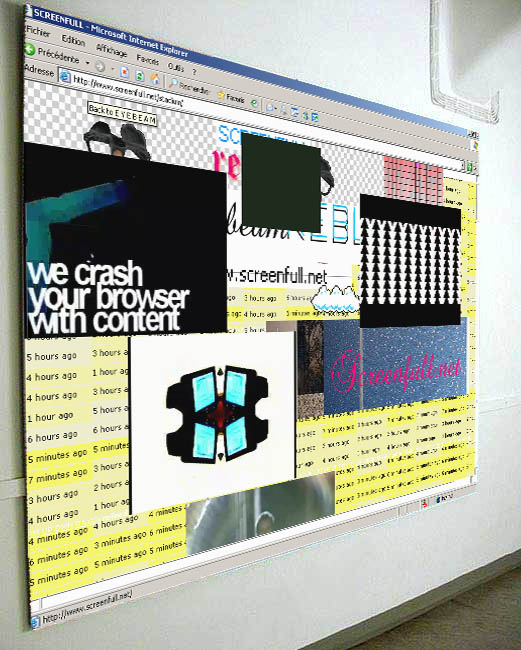
The images I posted earlier of wallpaper paintings evoking HTML frames have gotten the SCREENFULL treatment. Just in case your life wasn't "meta" enough.

"Calypsum 2" (formerly "Theme from PLUTE") [6.1 MB .mp3]
The volume level is a tad lower than other pieces: I discovered I was recording them too loud and they were clipping at high volume. This is my first work using "continuous controllers"--the filter sweeps aren't actually live. Why tire your hand turning knobs when you can draw a controller curve and let the machine do the work?
After putting up a "plute"-related graphic and adding a back story I changed the name of this piece. It sounds too dreamy and smeary to me to have such an obnoxious word in the title. "Ploot" is supposedly what atomic industry workers call plutonium; I was spelling it differently and may use it again, just not in this piece.
HTML Frame Paintings, etc.

From Olia Lialina's A Vernacular Web: The Indigenous and the Barbarians: "In 2003 the students of the Merz Akademie celebrated the First Ten Years of the WWW by creating an exhibition of objects that symbolized the landmarks of the web's history. The tribute to wallpapers consisted of a huge board of real wallpaper, (from OBI), arranged in a frame style layout. Even in this simple construction it was clearly the skeleton of a web page."

Lialina's article, which is highly recommended reading, covers many elements of early, DIY web design, such as "under construction" pages, homemade buttons, and collections of backgrounds, always in the context of how they've been replaced in a second wave of web practice, dominated by blogs and search engines. Here is a particularly funny comment on MIDI:
As all the instruments were standardized in 1983 the sound effectively goes no further than Italo Disco. There will never be any new and exciting sounds, only updated versions of old sounds. New sounds would only break the compatibility with all the existing MIDI files. Software vendors can't change the "trumpet" to a "Neptune's kinda honkashizzle" because, on the web, you can find all kinds of MIDI files that use the trumpet in many different ways. In this case the only solution is the lowest common denominator. The trumpet sound must fit into James Brown's "Sex Machine" in the same way it fits into "Ride of the Valkyries" by Richard Wagner. It does this by not really fitting into either. At least that's equality.[via]
The result is that most of the time MIDI files give the impression of somebody playing hit music on an electronic organ in the privacy of their own home. In reality this happens at village weddings or the annual gathering of a rabbit breeder's association.

From Brian Turner's posts at WFMU's Beware of the Blog (originally from Stay Free! Daily). His caption is "McMother." Stay Free! says it's a real European McD0nald's ad and not a parody and I guess I believe it but yeesh.
Recipes
Lately I've been cable-surfing the Food Network and digging its sundry cooking "how-to" shows, especially the Japanese version of Iron Chef. [insert long-winded exegesis of show.] Technologically based arts need their equivalent; in fact visual artists lag behind chefs in the eclectic "mixing it up" aesthetic of current haute food prep. Musicians fare somewhat better in this regard because music software and gear matured sooner than imaging software and gear (i.e., it's been "there" longer to jack with), but both music and art improve when practitioners think outside the (software) box, that is, think like Iron Chef Sakai. I'm not saying I do this all the time, but certainly my instincts are to mix media and in the spirit of the food shows, I offer the following recipes for a recent animation (top) and musical effort (bottom). Eventually I'll write a Dogma-like manifesto that codifies these practices as the only right way to make art, but right now I'm still exploring and I haven't reached the really pedantic stage yet.
Example 1
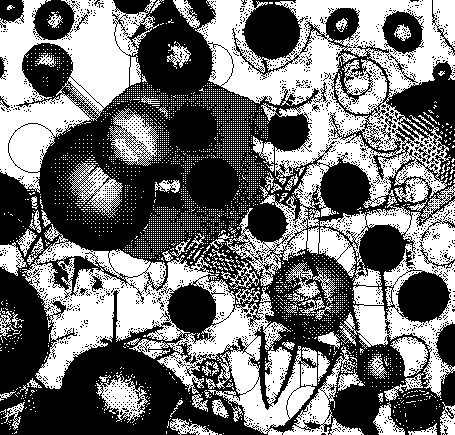
"Abstraction with Two Centrifuges" (2004), animated GIF
Drawings in MSPaintbrush are printed out at different sizes (100% to 600%), cut up with (real) scissors, taped back together in a scrambled collage.Example 2
That piece is finished. The GIF above is a spinoff work, no pun intended.
Collage is photographed with digital camera, detail is cropped and enlarged in Photoshop, converted to greyscale, run through the threshold filter.
In MSPaint, photoshopped image is converted to black and white fill patterns under "image attributes." (MSPaintbrush won't do this without destroying the original image). New fill patterns and the "centrifuge molecules" are added in MSPaintbrush. Saved 8 times, each save becomes a frame, with a different stage of the spinning molecules.
Frames are animated in a GIF building program. Uploaded to web, border is added in html.
"One to Thirty" [6.8 MB .mp3]. The following discussion is pretty brand-intensive, and I apologize for that, but one point I guess I'm trying to convey is that no one piece of software or hardware "makes" the piece; it's mostly in the process.
A factory-programmed tune from the Korg Electribe Amkii (B04 "Techno 12") is slowed down from 125 to 99 bpm. Audio is run through a standard hardware mixing board at low volume. The MIDI out is played by another synth, the Sidstation (a factory preset patch called P73 "Pyramid"), also plugged into the board.The common point of both works is using a combination of programs, effects, changes in resolution, etc. to build up some kind of credible texture. The overall goal is to give sound and image creative integrity beyond their source programming. These recipes are mostly technical. There are content issues arising at various stages of the process, verbalized internally but ultimately best left for the individual to articulate (or not).
The Sid basically only reads one sustained note and some noise, everything else is filtered out.
That note plays over and over as pattern B04 cycles, and is bent in real time with a variety of knobs: (i) the Sid's continuous controllers, changing the cutoff filter and pitch, and (ii) the dials on an analog filter called the Mutator (see below).
All of the above sounds are recorded into the computer through the mixer. But first, the board sends and returns audio from both synths to the Mutator, which uses some sophisticated envelope controls to twist and interweave the two instruments in real time.
An audio part is recorded using an analog to digital recorder (I forget which): about a 7-minute .wav file of the knob-twiddling performance. The file is then edited down to 4.5 minutes in a .wav editor called GoldWave: redundant and/or out-of-tune parts are snipped out.
The .wav file is imported into Cubase, a sequencer program. The tempo track is set at 99 bpm.
The drum riff is a sample that ships with Beatburner, a (virtual) rhythm module plugged into Cubase. Several were tried before I arrived at this one--I may have added some effects processing to it, but probably not. I also tried a MIDI drum part playing various samples. Beatburner plays this drum and bass riff at 99 bpm and it's a decent fit with the existing audio.
Content-wise, what I had in mind was a contradiction between the one, bent note, which is sort of airy Steve Reich minimalism, and the "slammin'" forward movement of that dancefloor beat. No dropouts, crescendos or other dancefloor tricks were used. The piece is still pretty energetic, and might pass for drum and bass, although most of these dance tropes are pretty cliche at this point. [skip long-winded exegesis]

This is my defacement of jimpunk's "the end" still, from back when he and Linkoln were doing (ending?) 544x378(WebTV). Orson only knows what screen gem supplied the still. I posted it on my animation log a while back but never put it up here. It gets a fair amount of traffic from google images.
The New York Times ran two articles on Takashi Murakami this week, Roberta Smith's review of the show he organized at the Japan Society, which I quibbled about here and here, and a magazine profile by Arthur Lubow, which I've only skimmed. The musician Momus writes about the latter piece on his weblog, from the angle that he's glad the Times has discovered post-Modernity and recognizes that the Japanese have long been living what the West mostly theorizes about. That is an interesting thing about them--especially the degree to which their popular culture explores the post-human melding of people and machines in the tropes of the cyborg, the giant robot, artificial environments, etc.
Still, do we need the extra loop of pop culture --> Murakami's traveling museum road show --> NY art dealers --> NY Times --> pop culture or do these ideas disseminate to the West just fine through your local video and comic book stores? In other words, if the Japanese have no "high-low" distinction (as these articles are saying) and if Murakami's art and Japanese pop culture are one and the same, why do we need Murakami making this culture available at a higher price level? I maintain his main function is to make Western curators feel better about themselves that they have multicultural content and are "down with the whole Japanese postmodern thing," and once he's in an institution then Chip and Muffy just have to have one. But his work is thin compared to the real thing.
On the high-low dichotomy, I said earlier the Japanese have no Romantic, starving-in-a-garret tradition, before reading in the Lubow article that Murakami famously sleeps on the floor of his studio. But hey, we all know some of the richest people in the world are some of the cheapest, bringing lunch to work in a brown bag, driving a beat up car, paying their employees nothing. That's how they got rich--by keeping their overhead down. In the Lubow piece a curator mentions the sleeping bag factoid, dutifully building the Zen monk artist hype around Murakami. Yet it's hard to square the image of this dude walking the earth like Caine in Kung Fu also licensing his designs for Vuitton handbags and going after a younger artist like Eric Doeringer who dares to appropriate his precious work. PT Barnum had a phrase that applies to many working in US art institutions.


Top: Kaba Kick, a Japanese game of russian roulette for kids (I forget where I found this). If you lose, a pair of feet kicks out of the gun, which is shaped like a pink hippo. Artist Takashi Murakami, who has made himself a market force in the West selling to curators and art critics the easily-digestible idea that Japanese pop culture is about that nation's "impotence," would no doubt have a field day with this. In the interests of giving equal time to an opposing meme, the bottom image is Captain Goto, from the long-running TV adventure series Patlabor. "Patlabor" is short for "patrol labor"; a "labor" is an oversized robot that, in the near-future sci fi world of the series, is used primarily for construction work. Occasionally the stressed-out drivers of these powerful contraptions go berserk and the "mobile police" (also driving labors) have to be called in to restore order. The show somewhat resembles Taxi in being centered around a daily, humdrum work environment and follows a group of regular characters, the overworked, underpaid cops of Division Two, which Goto commands.
Goto's much like Humphrey Bogart in looks and demeanor--a supersmart, supercool guy who never lets on he's figured out a solution to a complex problem until time to put the plan into action. The show's juice is the contrast between his staff's daily bickering and the absolutely harrowing situations the job puts them in. Driving the monster robots is treated like a 9 to 5 gig but requires lightning reflexes, aggressive fighting skills, and a tolerance for hastily improvised solutions. As boss, Goto deals stoically with equipment shortages, departmental infighting, and short-fused subordinates and almost invariably thinks his way to a solution. In other words, the show has universal, positive appeal, and the "impotence" of Japanese society is the impotence of any other society (like, say, watching the slow motion train wreck of Bush's Iraq war and not being able to do a goddamn thing about it). It is uniquely Japanese in its focus on the "how-to" of the robots and the group energy devoted to their maintenance, and in showing how Division Two's sharp idiosyncratic personalities eventually reach consensus: even with Goto's guidance it is usually teamwork that wins the day.
This makes the series sound earnest but it is in fact fairly subtle in balancing the difficulties of life in a complex urban/industrial society with an upbeat story line. The cops have a knack for arriving late and operating in a state of crisis, but they do their jobs and mechanized society grinds on.
I wonder if there are Japanese artists (commercial or otherwise) frustrated always to have Takashi Murakami playing "Mr. Japan" to western curators and art writers. In her New York Times review of a recent show of his and other Japanese artists' work at the Japan Society, Roberta Smith says
In the end Mr. Murakami has attempted psychoanalysis on a national scope in exhibition form, while creating what is arguably the most daring, thought-provoking show yet seen at Japan Society. Those who visit it stand an excellent chance of having their understanding of Japan, its culture and its history profoundly shaken.But aside from tourist brochures, Murakami seems to be dispensing the cliche wisdom about Japanese pop culture, that it reflects scarring by the atomic bomb (who wouldn't be scarred by that?) and is unhealthily obsessed with schoolgirls. Well, duh. He loves to go around saying how "impotent" the Japanese are, while he's made a mint "playing" Western curators (and handbag designers) with his faux-anime characters and anemic hard-edged paintings. The Japanese don't have a starving-in-a-garret tradition (or a contemporary art tradition per se), so they probably think he's cool for being so successful but I'd like to think there's somebody over there sticking pins in a Takashi Murakami doll.
In the U.S.A, back in the '70s, people jumped all over newscaster Harry Reasoner when he suggested Woody Allen's timidity with women in Play It Again Sam reflected the psyche of "a nation that had just lost a war" (Vietnam, yo). Yet we love it when Murakami puts his own country on the couch and calls its pop culture a reflection of its "impotence." Something smells here. What I get from anime is a good deal more sophisticated (and self-aware) look at the cultural currents driving this most productive and creatively gifted of countries. Anime is enjoyed all over the world, and not just as a symptom.
More here and here.

Spheres on Checks, 1994, gouache on 363 cancelled checks, linen tape, 90" x 66"
I had to yawn when I saw that Richard Prince's new paintings incorporated his cancelled checks. From the reproductions I saw, he didn't do anything interesting with them, like paint several hundred spheres on them. This reproduction is pretty grainy; a slightly more detailed version is here.
There was an error hanging up the XML feed for my page. It's fixed, at least on my end, so the site should be feeding again. Thanks to SCREENFULL for pointing out the error. You guys are doing a fine job over at the eyebeam reBlog.

The Boy Who Liked Chicken, 1990, acrylic on canvas, 9" X 12"
Another scrupulous music diary entry. The three tracks I last posted begin and end abruptly so they can be looped. "hiphop_guitar" and "darkest_nerk_scanner" are just fragments, but dense enough to be the seeds of longer songs. Eventually more phrases and instruments will be added but I felt like posting them. "free_alpha" is a complete, albeit completely simple song written for a synth called, um, Free Alpha, that came free with a book I bought on softsynths. I think the sound is ear-tickling gorgeous and I plan on experimenting more with it. Another product from the Linplug company that came with the book is the RM F, which is a rhythm sampler/beatbox thing. I was fooling around with it last night, and got it to play the "Miles Sampler Kit" I downloaded a few months ago from humanworkshop in the Netherlands. Someone sampled drum hits and a bass from an old Miles Davis (electric period?) LP and the RM F plays them like a drum kit. What I did wasn't good enough to post but it's another milestone in my learning process. (For some reason it didn't work in Kontakt; I need to try again.) I used the velocity controller in the sequencer to emphasize certain beats during a fade-in, which sounded kind of cool.
UPDATE: OK, I got the Miles Kit fired up in Kontakt (a software sampler) and wrote a little tune for the dead guy to play. I feel like Herbert West, Reanimator--except the tune isn't all that lively.
Miles Kit Experiment [mp3 removed]
UPDATE 2: This is the "free_alpha" bass line with a new lead--a really sweet Sid patch called "inshore":
"Alpha Inshore" [mp3 removed]
Okay, big props to Bill for guest-posting today. Definitely check out that "America heals" video he, I mean I posted on his page. It's funny and all because it's over the top kitsch but it makes me angry because I feel the whole red state response to 9/11 was so orchestrated by the media. (No offense to my friends in those states, I'm speaking of the monkeymass who supported the Iraq war.) 9/11 wasn't a war, it was a terrorist act by individuals, and everybody got all jacked up into Pearl Harbor mode. Pearl Harbor the movie flopped but this made the entertainment industry (including news outlets) quite a few bucks. Dave contrasts that schmaltzy video with Matt Freedman's twin towers pieces I just posted, cheekily suggesting that it's the former, not the latter, that will communicate the agony of the day to the greatest number, but I think the "crusty, unempathetic" New York art world has as much claim on the day--no, more--because they live here and went through it, as opposed to the millions who experienced it vicariously on the boob tube and then went into bombadier mode.

LA Drunk Tank, 1955
--bill schwarz
I'm supposed to be guest-posting for Tom today but he laid down so many rules for his page I kind of don't feel comfortable saying much. I predict much of the action will be on my page where Tom is posting as me, I mean, guest blogging for me in a reciprocal arrangement. Please check out this post-9/11 red state inspirational music video, it's way better than the arty stuff I, I mean, Tom posts. And scroll down to see what Tom, I mean I, and others have to say about it. Abraham Kalashnikov's reading is especially good. --bill schwarz
This song was popular in 1972 (at least on FM, "underground" radio--I was thinking it was Cheech and Chong but it was David Peel). It's all this page has to contribute by way of commenting on what is surely the Most Momentous News Story of Our Age, the passing of you know who:
The Pope Smokes Dope
David Peel and The Lower East Side
Chorus:
The pope smokes dope, God gave him the grass
The pope smokes dope, he likes to smoke in mass
The pope smokes dope, he's a groovy head
The pope smokes dope, the pope smokes dope
(oh yeah! 3x)
*
God is high on mescaline, Satan's high on smack
Popes in Rome get stoned on grass, Jesus freaks are back
Jesus Christ a super-hippie never shoot up junk
Popes in Rome get stoned alone, priests, in church get drunk
(Chorus)
Now Jack 'n' Jill went up the hill, to fetch a pail of water
Jill forgot to take her pill, now she's got a daughter
Taking pills is not a joke for a groovy Pope
Birth control can be a toke of marijuana smoke
(Chorus)
The pope is getting higher (re: higher! higher! - 4x)
(Chorus)
Cha! Cha! Cha!
Two interesting discussions of electronic music:
Kim Cascone on glitch music
Kelefa Sanneh vs Ben Neill on Moby [via NEWSgrist]
Both talk about music as "post-" something--Cascone uses the term "post-digital" and Sanneh/Neill hash out the meaning of Francis Fukuyama's "end of history" in the pop music context. Also, both use the dreaded term "electronica." Yes, it's just shorthand but it still violates a major tenet of Ishkur's Guide (now in version 2.5!):
This quote from Neill is especially good:
...um, Classifications Consortium.
With design superseding art, art appropriates the commercial because otherwise it feels obsolete, and art changes from a product industry to a service industry. Dematerializing, if you will. Is that bad? Is that why we have “the end of music”? I think it’s more because in today’s sensational story-driven world, how can something as mental as “Music” (especially instrumental music, which is nearly impossible to write about and therefore to sell) compete with gang wars between rappers and Michael Jackson’s sex scandals?He's defending Moby as a symptom of something good that almost happened in pop music in the '90s (anonymity, decentralization, no more friggin rock stars). Sanneh is somewhat knowledgeable (but snide) about the "paradigm shift" electronic dance music almost pulled off back then, but is still attached to the "great man" view of history--and the paradigm of newspapers needing stories on said friggin rock stars--and thus gives Moby disproportionate credit (on the up-side of his career) and blame (on the down) as a "shifter."
"hiphop_guitar (fragment)" [mp3 removed]
"free_alpha" [mp3 removed]
“darkest_nerk_scanner” [mp3 removed]
Starting tomorrow, I'll be having a guest blogger. It's Bill Schwarz. That will be taking up most of his time, so I'll be guest blogging over at Schwarz. Be sure to let us know if you can tell the difference.
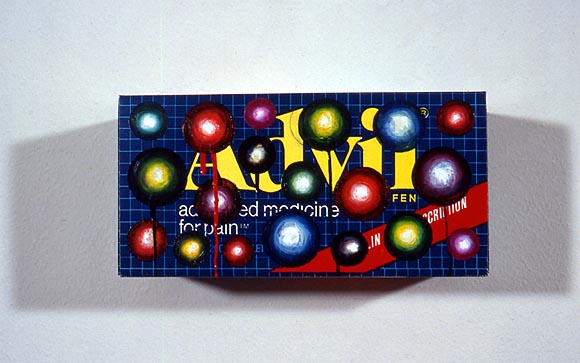
Advil Box, 1994, acrylic on promotional display box, 16.5 x 8 x 8.5 inches
"Drum Thing" [mp3 removed]
"Mutated Drums" [mp3 removed]
"Drum Thing" is played with six sampled drumkits--sort of like chamber music with the same beat; "Mutated Drums" is another pattern played live through an analog filter--more of a "knob workout," as we say.
Here in New York the fall of the twin towers etched a pretty deep scar in the civic consciousness. Everyone was affected by it in some way, and people still have a hard time talking about it. Unlike the millions around the U.S. who goggled at the event over and over on TV, in this city it was a lived thing. Ironically it was those TV-gogglers, with no direct experience of the tragedy, who bayed most loudly for war. People here just wanted Bush to stop stirring the pot. (Not everyone, but hundreds of thousands turned out for demonstration after demonstration.) Below, images of New York artist Matt Freedman's work at vertexList, from a two person show with Jude Tallichet. Shades of Richard Dreyfuss and the Devil's Tower in Close Encounters of the Third Kind: the damn things get to you.




Intellectual property law might have gone in a very different direction if not for Judge Sol Kramer and his "Lighten the Fuck Up" rule. One shudders to think what the world would be like for creative people if this crusty New York jurist hadn't been sitting in the Southern District federal court, where a succession of copyright cases inevitably wound up in the '80s and early '90s. That rare lawyer who actually understood art and music, Judge Kramer created an intimidating series of precedents that shaped the course of U.S. artistic history. It's amusing to think back now at the judge's use of salty language in the courtroom as plaintiff after plaintiff made its case and came away disappointed. Of course, the written opinions that followed were exquisitely reasoned and delved deeply into the minutiae of the respective artworks, guided by the judge's strong and principled belief that, while these matters had to be taken on a case by case basis, creativity ultimately had to be protected from the drag of frivolous lawsuits. The following are some his jabs from the bench:
"Your honor, my clients Messrs. Kaylan and Volman, aka the Turtles, have been severely damaged by the indiscriminate sampling of their world famous string intro to the 60s hit 'You Showed Me,' in De La Soul's 'Live Transmission from Mars.'"
"Oh, lighten the fuck up. 'Live Transmission' is a one-off novelty song, hell, it's not even a song, it's a little ambient piece. Get out of my courtroom."
"Representing myself, your honor, I am appalled that Jeff Koons took my image 'String of Puppies' and made a sculpture out of it and I seek a milllion dollars in damages."
"Oh, lighten the fuck up. His work is in the museum and yours is in the museum shop. Not the same market at all. He did you a favor publicizing that sentimental fluff, you should thank him."
"'My Sweet Lord' uses the exact same melody as 'He's So Fine.'"
"Yeah, but everything else about it is different. Lighten the fuck up."
[More "lighten the fuck up" rulings will be added as I think of them. In reality, every one of these trivial nuisance suits was treated as a matter of grave importance by the courts and contributed to the awful muck that is copyright law today. The judge's description of the "String of Puppies" photo was softened even though I think the photographer was an ass for suing. I mean, he made an ordinarily uplifting photo and Koons ridiculed it all the way to the bank--just deal, sometimes things happen when you put sickly sweet crap out there in the world. --tm]
"One to Thirty" [mp3 removed]
This is drum and bass. This is that note.

From indymedia: William Kristol Gets Pied
William Kristol, founder of the Project for a New American Century (a leading neo-con think tank) and a key figure in American foreign policy for over 20 years, was hit by what appeared to be a cream pie tonight in Richmond, Indiana. Throughout his speech, given at Earlham College, he defended the "Bush doctrine" of pre-emptive war and state terror and was in the process of comparing current policy challenges to those of the early Cold War when a young man calmly lifted himself onto the stage and quickly walked to the podium, splattering a delicious dish all over the speaker as well as the college's president (collateral damage, perhaps?).It's not quite the Cronenbergian exploding head I thought it was when I first saw the photo, but I'll settle for a pie for this war-mongering moFo. I realize "Americans don't care about the war," which is why Bush squeaked in again (with a little cheating), but many of us here in the New York metro area are tired of having this violent, inept cadre in office. They're admitting they failed in Iraq, otherwise Wolfowitz and Feith would be moving up in the Defense Department, instead of being shunted aside.
Unfortunately, after a period of shock, many people in the audience stood and clapped to show support for Kristol (for a total of three standing ovations), including many self-professed peace activists and liberals who were afraid that this succulently sweet action would discredit Earlham College. They apparently forgot, perhaps due to his liability as a speaker, of Kristol's central role in the Reagan and Bush I administrations, his long efforts as a Harvard-trained political scientist to provide the intellectual justification for the Bush agenda of foreign intervention, and his current place as an architect of a war in Iraq which has claimed tens of thousands of innocent lives.

